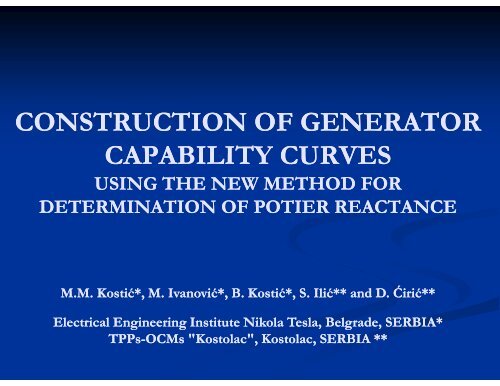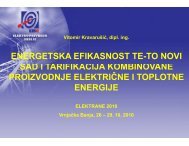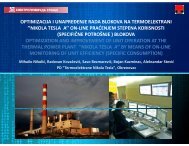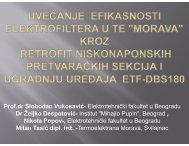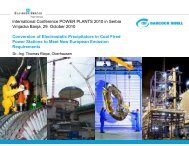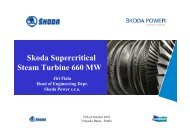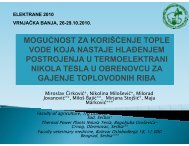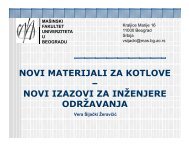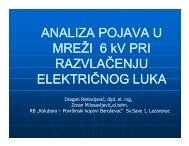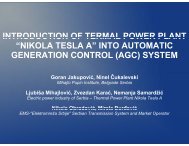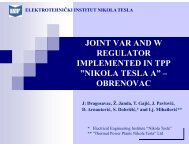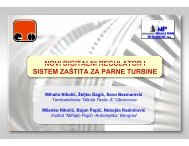CONSTRUCTION OF GENERATOR CAPABILITY A CURVES
construction of generator ca atcs ca atcs capability curves
construction of generator ca atcs ca atcs capability curves
- No tags were found...
Create successful ePaper yourself
Turn your PDF publications into a flip-book with our unique Google optimized e-Paper software.
<strong>CONSTRUCTION</strong> <strong>OF</strong> <strong>GENERATOR</strong><br />
<strong>CAPABILITY</strong> A <strong>CURVES</strong><br />
USING THE NEW METHOD FOR<br />
DETERMINATION <strong>OF</strong> POTIER REACTANCE<br />
M.M. Kostić*, M. Ivanović*, B. Kostić*, S. Ilić** and D. Ćirić**<br />
Electrical Engineering Institute Nikola Tesla, Belgrade, SERBIA*<br />
TPPs-OCMs "Kostolac", Kostolac, SERBIA **
Abstract<br />
• The capability (P-Q) curve of generator can be determined only on<br />
the base of examinations in the power plant, i.e. on the base of:<br />
• the no-load test, i. e. i fl (e l ) dependence, and<br />
• the reactive load test, i.e. characteristic points A i (i f , u)<br />
• The Potier reactance (X P )forthe34 3-4 points of the relevant values<br />
of reactive loads are determined, and then<br />
the capability (P G -Q G ) curve of the generator is being constructed.<br />
• This method is verified for experimental regimes of active and<br />
reactive power around the nominal values, on the example of turbo<br />
generator 348 MW in power plant "Kostolac B".<br />
• The significant deviation in relation to the P-Q curve of the drive<br />
manufacturer's documentation generator were established, and<br />
it is recommended d to update P-Q curves every 5-6 years or after<br />
major repairs.<br />
• Similar deviations of P-Q curves were observed during the<br />
extensive testing and research for newer generators in U.S.
Introduction<br />
• Capability curves, P G -Q G curves, Figure 1, are necessary to the<br />
operating stuff.<br />
• The most important part of the curve is the part with coordinates<br />
(Q G ≥ Q G,N , P G ≤ P G,N ) which defines the generator regime with<br />
increased reactive power.<br />
• Significant deviations of capability curves, compared to<br />
manufacturers’, were obtained during the extensive testing and<br />
research for generators in U.S. (Figure 1).
Introduction<br />
Figure 1: Comparison chart of actual capability (P-Q) curves with the manufacturers' generator capability curves
BASIC PRINCIPLES FOR THE DESIGN<br />
<strong>OF</strong> <strong>CAPABILITY</strong> CURVE<br />
• Capability ity curve of generator e with unsaturated sauaed<br />
magnetic cc circuit<br />
cu<br />
• Generator is sized to reach the nominal<br />
temperature at the rated values of (p n ) and (q n )<br />
powers (the point R) i.e.:<br />
• for induct currents, i a = i an = Const.,<br />
φ ≤ φ n ,<br />
and<br />
• curve i f = Const. . and φ > φ n , i.e., q ≥ q R , with a<br />
reduced active power p ≤ p R<br />
Figure 2: Vector diagram of generator electromotive forces and the<br />
excitation currents (with corresponding scaling ratio)
BASIC PRINCIPLES FOR THE DESIGN<br />
<strong>OF</strong> <strong>CAPABILITY</strong> CURVE<br />
• Vector diagrams of excitation currents of saturated machine<br />
• The curve of saturated machine, derived from no-load test, i f0 (e)<br />
• It is particularly difficult to quantify additional magnetic saturation on the<br />
part of the rotor of loaded d machine, i.e. . i fl = f(e l ).<br />
• Influence of additional saturation of the rotor magnetic circuit is taken into<br />
account by introduction of Potier reactance (x P >x l , x l is stator leakage<br />
reactance) which h results in increased EMF( (e P = u+x P·i<br />
> u+x+ l i = e l ).<br />
Figure 3: Magnetization curves i f0 (e) and i fl (e l ); diagrams of excitation currents: i fa,n = x d -x P and i fR<br />
fR =i fP +i fa,n
BASIC PRINCIPLES FOR THE DESIGN<br />
<strong>OF</strong> <strong>CAPABILITY</strong> CURVE<br />
• Capability ity curve of generator e with saturated a magnetic circuit<br />
cu<br />
• The increase part of saturation current<br />
• Δi f (e P ) = Δi fu<br />
+ Δi fs+ Δi fr (Figure 3)<br />
• beginning point C uns goes down for Δi f (e P ) (C R ,C 1 ,C 2<br />
and C M )<br />
• the corresponding arches i fi =Const Const. are moved<br />
down as well.<br />
• Thus, for pure reactive load (p = 0),<br />
• instead of point q' M , point q M < q' M is obtained<br />
• q' M - reactive load maximum for generator with<br />
saturated magnetic circuit.<br />
Figure 4: Diagrams of electromotive forces and excitation currents<br />
for generator with saturated magnetic circuit
DETERMINATION <strong>OF</strong> <strong>GENERATOR</strong>S<br />
POTIER REACTANCE<br />
• Potier reactance is not constant in given range of voltage and load.<br />
• It is necessary to determine the Potier reactance dependence x P (u,q):<br />
• for accurate calculations and<br />
• capability curve construction.<br />
• Determination of Potier reactance for relevant (reactive) loads:<br />
xp( p (P Gi ,Q Gi ) ≈ xp(Q<br />
p Gcosφ=0 G,cosφ=0 ),, for Q Gi = Q Gcosφ=0<br />
G,cosφ=0<br />
since<br />
U G (P Gi , Q Gi ) ≈ U G (Q G,cosφ=0 φ ),, for Q Gi = Q G,cosφ=0<br />
φ<br />
and<br />
x p =f(Q<br />
G ,U G )≈ f(Q G )<br />
For rated regime (P Gn , Q Gn , U n ):<br />
x P,n ≈ x’ P90 , for i 90 ’ =i an·sinφ<br />
n …………………………………. (1)<br />
In general case (P G , Q G , U):<br />
x P ≈ x’ P90 , for i 90 ’ =i a·sinφ<br />
…………………………………….<br />
(2)
DETERMINATION <strong>OF</strong> <strong>GENERATOR</strong>S<br />
POTIER REACTANCE<br />
• The obtained values (dependences) of Potier reactance<br />
x p =f(Q<br />
G ,U G )≈ f(Q G,cosφ=0 ) should be used for design of generator<br />
capability curve.<br />
• The specified rule was verified on the example of generator<br />
GTHW360 (360 MW) for regimes around the nominal (P G ≈P Gn and<br />
Q G ≈Q Gn ), )iebycomparisonof:<br />
i.e. of:<br />
• measured values (I f ,meas), and<br />
• calculated values (I f,calc ), on the basis of Potier reactances (x P ) for Q G,cosφ=0<br />
And, it is obtained<br />
I f,calc =I f,meas ±0.4%<br />
G,cosφ=0 ≈Q Gn .
DETERMINATION <strong>OF</strong> <strong>GENERATOR</strong>S<br />
POTIER REACTANCE<br />
• In Figure 5 is given a dependence of Potier reactance, ce, x p,i pi (Q G ), for<br />
generator GTH-360<br />
• The Potier reactance (x p ), is changing when<br />
reactive power changes.<br />
• These values decrease with increase in load, but<br />
• Potier reactance value is greater then leakage<br />
reactance, x p,min ≈ 1.1÷1.151.15 x l<br />
Figure 5: Dependence of Potier reactance from reactive power, x pi ( x pi<br />
(Q G ), and x l = 0.188 > x pmin<br />
pi (Q
<strong>CONSTRUCTION</strong> <strong>OF</strong> <strong>GENERATOR</strong><br />
<strong>CAPABILITY</strong> CURVE<br />
• Determination of P-Q curve by a new method<br />
• The values of excitation current (I f ) can be calculated using the following<br />
expression (which is derived from a triangle <strong>OF</strong> R F R ', Figure 3):<br />
i<br />
fR<br />
[ i + ( x − x )( s / u)(sin<br />
ϕ cos ∂ + cosϕ<br />
sin ∂)<br />
] 2 + [(<br />
x − x ) ⋅(cosϕ<br />
cos ∂ − sin sin ∂ ) ] 2<br />
= ϕ<br />
fP<br />
d<br />
P<br />
d<br />
P<br />
• For given (nominal) value of excitation current (i fn =i fR =Const.) )<br />
• Corresponding values of active power (P Gi ) are calculated,<br />
• the independent variable takes the value of reactive load Q Gi ≡ Q Gi,cosφ≈<br />
• For a given value of excitation current I f1,max<br />
= 2550A:<br />
Gi,cosφ≈0.<br />
• the series of given values of reactive and active power were obtained,<br />
• the corresponding P-Q dependence is obtained (Figure 6).
<strong>CONSTRUCTION</strong> <strong>OF</strong> <strong>GENERATOR</strong><br />
<strong>CAPABILITY</strong> CURVE<br />
Figure 6: Capability diagrams for generator GTHW-360: curve from manufacturer's documentation ()<br />
significantly deviates from the curve obtained during tests (---)
Conclusion<br />
• It has been established that manufacturers' P-Q curve for generator<br />
GTH 360 gives overestimated reactive power values by 2%, 4%<br />
and 6%, for reduced active power: 250MW(0.71P G,N ),<br />
200MW( 0.581P G,N ) and 50MW, respectively.<br />
• Similar deviations were observed during the extensive testing and<br />
research for newer generators in the U.S.<br />
• Therefore, it is recommended to update P-Q curves every 5-6 years<br />
or after major repairs.
PROPOSAL FOR ADDITION <strong>OF</strong><br />
IEC 34-4 4 STANDARD<br />
IN PART FOR DETERMINATION<br />
<strong>OF</strong> POTIER REACTANCE<br />
M.M. Kostić*<br />
Electrical Engineering Institute Nikola Tesla, Belgrade, SERBIA*
Abstract<br />
The author came to the following conclusion:<br />
• The Potier reactance value depends almost on turbo generator<br />
reactive current (i aQ = i an·sinφ),<br />
• This rule is proved by:<br />
• general qualitative analysis, and<br />
• experiment<br />
• Thus, the addition of corresponding standard IEC 34-4/1985: 4/1985:<br />
ROTATION ELECTRICAL MACHINES is proposed, i.e. it is<br />
proposed that the Potier reactance should be determined from<br />
reactive load test:<br />
• for the excitation current which corresponds to the rated voltage and armature<br />
current value i’ a,cosφ=0<br />
= i an·sinφ<br />
n , and<br />
• two additional values of reactive load i’ a, cosφ=0<br />
> i an·sinφ<br />
n , which are convenient<br />
for construction of turbo generator capability (P-Q) curve, for the segment<br />
where Q > Q n .
Introduction<br />
• The armature leakage reactance is usually approximated by the Potier<br />
reactance.<br />
• The values of the Potier reactance is greater than the leakage<br />
reactance (up (p to 50% of the leakage reactance, which is confirmed by<br />
the results of our research).<br />
• The importance of Potier reactance determination is reflected in:<br />
• Leakage reactance is nearly independent on saturation (X l = Const.).<br />
• Saturation curve of the generator under load conditions is assumed to be the<br />
same as the open-circuit saturation curve.<br />
• Any error introduced by the use of the open-circuit saturation curve is<br />
compensated by using the Potier reactance (X p >X l ).<br />
• For turbogenerator, the air gap is assumed to be uniform so that<br />
• the direct-axis reactance is equal to the quadrature axis reactance, X d = X q<br />
• the unsaturated direct-axis reactance is calculated by equation X du = X a + X l .<br />
• In numerous researches it is shown that Potier reactance values<br />
depend on terminal voltage.
THE POTIER REACTANCE<br />
DEPENDENCE ON (REACTIVE) LOADS<br />
• Based on research results, author came to the following conclusion:<br />
• The Potier reactance mostly depends on reactive currents (i aQ = i an·sinφ),<br />
• It is verified by:<br />
• general qualitative analysis, and<br />
• experiment, for loads about rated active and reactive power, for generator<br />
GTHW 360 (360 MW)<br />
• Standard procedure for determining Potier reactance is based on reactive load<br />
test with voltage and current which differ from their rated values by not more<br />
then ± 0.15 per unit.<br />
• Author proposes that Potier reactance should be determined from reactive load<br />
test for three values of armature current:<br />
• I a1 =I a,max >I aN·sinφ<br />
N (i.e. Q G1 =Q Gmax >Q GN ), corresponding to I f =I f,N and U G1 = U G at<br />
Q G1 =Q Gmax >Q GN (point C 1 , Figure 1);<br />
• I a2 =I aN ·sinφ<br />
N (i.e. Q G2 =Q GN )andU<br />
U G2 =U G at Q 2 =Q N (point C 3 , Figure 1);<br />
• I a3 =(I a1 +I a2 )/2, i.e. Q G3 =(Q Gmax<br />
Gmax +Q GN<br />
GN )/2 and U G3 =U G at Q G3 point C 2 , Figure 1).
DETERMINATION <strong>OF</strong> POTIER<br />
REACTANCE (STANDARD PROCEDURE)<br />
Figure 1: Determination of the excitation current at zero power-factor for three experimental points<br />
i 1 (C 1 ) > i 2 (C 2 ) > i 3 (C 3 ), and corresponding (accessory) points A 1 , A 2 and A 3
DETERMINATION <strong>OF</strong> POTIER<br />
REACTANCE (STANDARD PROCEDURE)<br />
Fig. 2: Potier reactance, for three different exitation current at zero power-factor,<br />
X P (A 3 (C 3 ) >X P (A 2 (C 2 )) > X P (A 1 (C 1 ), for i a (C 3 )< i a (C 2 )
Potier reactance dependence on the load and<br />
the new method for its determination<br />
• Reactances x Pn and x Pn,90<br />
are determined using new method (Figure 3)<br />
Fig. 3: Vector diagrams of electromotive forces (e P )and(e) l ), and procedure for determining the Potier reactance (x P )<br />
-x Pn<br />
Pn for the rated generator regime (u = u n , i = i n and φ = φ n ), from 1-6;<br />
-x Pn,90 for the reactive load with rated current (u n , i n and φ = 90 o ), from 7-8;<br />
x Pn,90 < x Pn
Potier reactance dependence on the load and<br />
the new method for its determination<br />
Fig. 4: Vector diagrams of electromotive forces (e P ) and (e l ), and procedure for determining the Potier reactance (x P )<br />
- x P,90 (i an<br />
- x Pn for the rated generator regime (u = u n , i = i n and φ = φ n )f ), from 1-6;<br />
16<br />
an sinφ n ) for the reactive load with armature current i a,90 = i an sinφ n u=u n , and φ = 90 o ), from 7-8,<br />
x Pn ≈ x P,90<br />
P,90 (i an<br />
an sinφ n )
Potier reactance dependence on the load and<br />
the new method for its determination<br />
• The Potier reactance value for the rated regime (x Pn )is<br />
approximately equal to the value of the reactive load<br />
i’ = i an·sinφ<br />
n (u = u n , i’ = i an·sinφ<br />
n i φ = 90 o ), i.e. (Figure 4):<br />
x P,n<br />
P,n = x’ P,90<br />
, for i 90 ’ = i an· · sinφ n ……………………….… (1)<br />
• This rule was verified on the example of generator GTHW 360<br />
(360 MW) for regimes around the nominal (P G ≈ P Gn and<br />
Q G ≈ Q Gn )i ), i.e. by comparison of:<br />
• measured values (I f,meas ), and<br />
• calculated values (I f,calc ), on the basis of Potier reactances (x P ) for<br />
Q G,cosφ=0<br />
≈ Q Gn .<br />
And, it is obtained<br />
I f,calc = I f,meas ±04% ±0.4%
Potier reactance dependence on the load and<br />
the new method for its determination<br />
• Based on the equivalence (1) and Figure 4, it is possible to write a<br />
general equivalence<br />
x P,n<br />
P,n = x’ P,90<br />
, for i 90 ’ = i a· sinφ n ………………………….. (2)<br />
• The explanation is based on following facts:<br />
• The electromotive force has approximately the same values (e P ≈e l ), in<br />
• reactive load region i’ = i an·sinφ<br />
n and<br />
• nominal generator region, i.e. e’ l90 90≈e ln =0B and e’ P90<br />
≈ e Pn =0C (Figure 4),<br />
• The corresponding components of the magnetic leakage of<br />
• the rotor excitation coil and<br />
• the armature winding (on the stator),<br />
depend mostly on the reactive load.
Conclusion<br />
• Based on these results, it is concluded that the Potier reactance<br />
values mostly depend on the reactive load component (i aQ = i a·sinφ).<br />
The above hypothesis was verified by<br />
• general qualitative analysis, and<br />
• experiment, for loads about rated active and reactive power, for generator<br />
GTHW 360 (360 MW)<br />
• Author proposes that Potier reactance should be determined from<br />
reactive load test for three values of armature current.
Thank you for your attention


